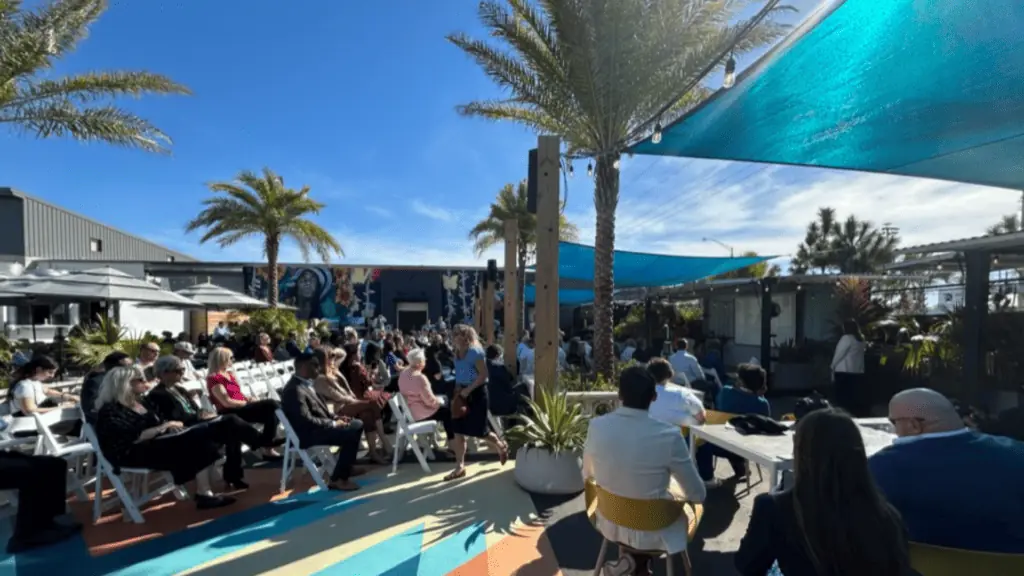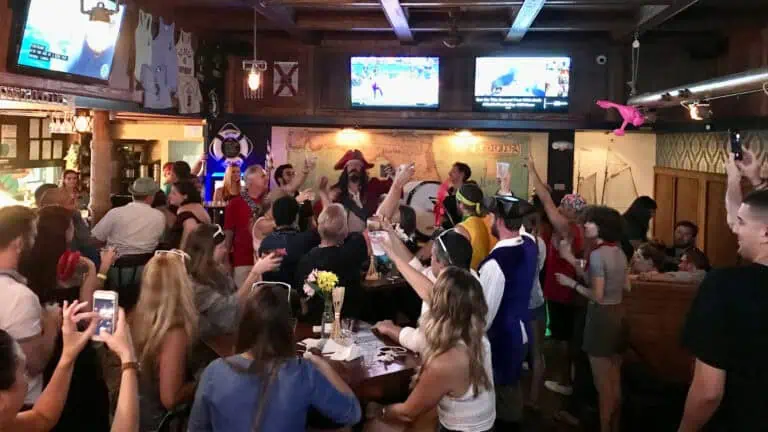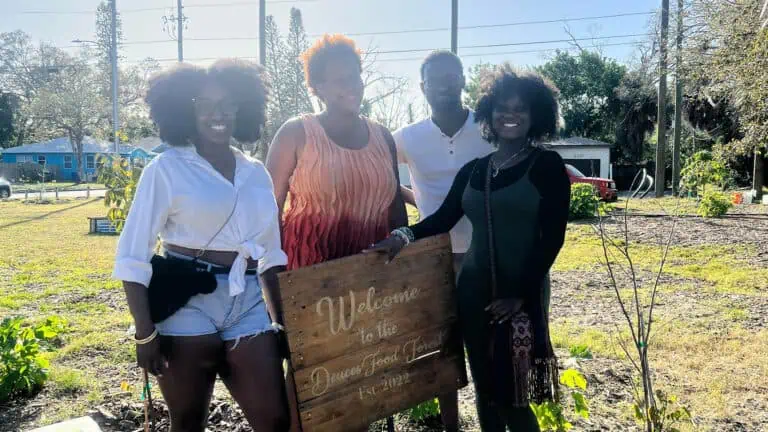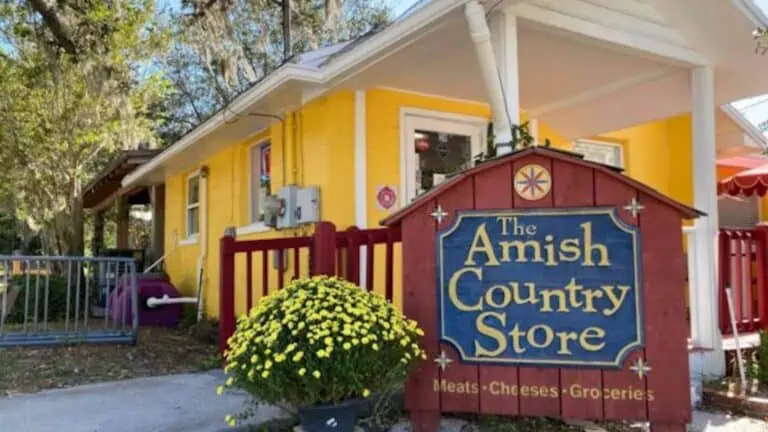The Downtown Partnership held its fourth annual Downtown Development Summit at the St. Petersburg Distillery on Wednesday and the takeaways might surprise some people. Speakers and statistics throughout the afternoon continually returned to a few common themes:
It’s not all luxury condos being built downtown. St. Pete needs more office space. And we must build our way to affordable housing.
ADVERTISEMENT
The beautiful February weather reminded the diverse audience of developers, city officials, affordable housing advocates, and business leaders of exactly why St. Petersburg is a city in high demand. But rather than relaxing in the sunshine, the Downtown Partnership offered a meaty agenda, packed full of revealing statistics and illuminating observations from local and national experts. Read on for some of the afternoon’s highlights, including surprising statistics, development trends, and areas of concern:
Accolades and statistics point out what we already know, but also reveal some surprises

Sarah Lindemuth, Research Director for the St. Petersburg Downtown Partnership revealed some highlights from the recently released Downtown St. Pete Development Guide. Among the biggest surprises:
- It’s Not all Luxury Condos: Lindemuth noted the common assumption that all of the new development downtown is luxury condos, and the concern that many current residents share that new development “ is going to significantly change the makeup of who we are in downtown St. Pete.” She went on to bust that common myth: “If you look at the approximately 8,000 units that are in the pipeline, the breakout is 82% are rental units, 15% are condos and 5% are townhomes. So that dispels that concern that it’s a lot of condos that are shifting the makeup of who we are.”
- Affordability in Downtown is Slowly Improving as New Rental Units Come Online. Lindemuth said “One of the biggest factors to reduce housing costs is to increase housing supply. Over the past year there was a 7% increase in residential rental units downtown and we saw declines in rental rates for Studios, 1 bedroom, and 2 bedroom apartments.” She noted that was not a trend that was felt nationally, in the south, or even the larger metro area.
- Downtown’s Population has Increased by 11% in the past 5 years, and 27% in the past ten years, for a population that is currently around 17,000 people. (For reference, the City of St. Petersburg’s population increased just 5% from 2010 to 2020.)
- There are 8,700 Existing Residential Units Downtown, with another 2,200 units Under Construction and 5,900 Units in the proposal Stage. (Note: these statistics do not include the potential Gas Plant District development.)
- The Demographic Profile of New Downtown Residents Skews Younger, Lower Median Income, more College Educated, more Female, and more Unmarried than the existing downtown population.
- Many New Downtown Residents are Moving from Within Pinellas County. Lindemuth noted, “That’s people that know what’s happening here, like what’s happening here, and are intrigued by an urban environment.”
- 34% of all the New Hotel rooms proposed for Pinellas County are in Downtown St. Pete, revealing that downtown has become a strong visitor attraction for the county. Last year, 226 hotel “keys” (rooms) were built in the city, with another 1128 keys in the proposal stage.
- Bus Rapid Transit is Spurring Development along the Sunrunner line Downtown, with 31 projects including 4,000 planned residential units in the works.
- There is Not Enough Office Space Downtown. The office vacancy rate downtown is 5.6%, compared to 19% nationally. While this seems like a positive statistic, it reveals a lack of supply, and poses a threat to efforts to recruit new business to the city and to provide space for growing local businesses.
- Collaborative and Coworking Spaces have Created a Safety Net for office supply. St. Petersburg currently has 200,000 square feet of collaborative and coworking space downtown and four new collaborative work spaces have opened up in the past year, with an 86% occupancy rate. This creates a concern that, if all of the workers and businesses utilizing those spaces were ready to move into traditional office space at the same time, St. Petersburg wouldn’t have the space available for them.
- Downtown St. Petersburg Performs Better than Peer Cities in Many Areas including: share of overall jobs located downtown; share of jobs that are considered “knowledge jobs and creative jobs” (revealing a strong diversity of employment); share of the city’s assessed property value; share of the city’s total population that resides downtown; and walkability and bikeability scores.
- The City’s Focus on Equity is Being Noticed: St. Petersburg has received a perfect score in the municipal equality index for ten years straight. The accolade, awarded by the Human Rights Campaign, looks at policies and practices for equity in the city.
- Green Space Drives Development: The share of the city’s population who live within a ten minute walk of green space is steadily increasing, revealing that new development is concentrating around green space areas.
- St. Pete’s Educational Pipeline is Producing a Healthy Flow of New Graduates: The number of degrees being awarded by institutions of higher education close to downtown and in surrounding areas are on the rise. Notably, the STEAM degrees awarded to BIPOC students are also on the rise.
Panel discussions highlight trends and threats in residential, office, and affordable housing development

Three separate panel discussions touched on the topics of residential development, office space, and affordable housing. Takeaways included:
ADVERTISEMENT
Residential:
- Walkability is the biggest draw for high rise luxury condos, followed closely by view. Brian Van Slyke, Regional President of Kolter Urban, noted that today’s luxury condo buyer wants the energy, vibrancy, and lifestyle of the urban core. And if it can be paired with a great view, “that’s your homerun.”
- The St. Pete Residential Market is an Ecosystem: Will Conroy, Founder and President of Backstreets Capital, noted that not every buyer wants to live in a large, highly amenitized building, so “We tend to build smaller, boutique buildings.” Likewise, buyers that love a neighborhood like Euclid-St. Paul with its “walkability, great sidewalks, great school, great church” might not want to live in a single-family home, so Backstreets is creating a townhome development on the east side of the neighborhood to cater to those potential buyers.
- Development Creates Vibrancy, and vice versa: Jeff Craft of Tampa Bay City Living spoke about his company’s new developments at Ninth Street and Arlington, and noted the pedestrian traffic they create for local businesses. Will Conroy expanded on the idea, noting that “ Buildings, sidewalks, and streets don’t make neighborhoods. People do. People live there, work there, shop there. Sometimes developers get credit for building beautiful buildings, but really it’s the people that make that neighborhood. He also credits entrepreneurs like 3 Daughters Brewing who move into an area and make it an attractive location for new development.
- New Development Contributes to the Tax Base and Spurs further Growth and Economic Development. Van Slyke noted that Kolter’s three downtown developments have added “Hundreds of millions of dollars of property value” to the tax rolls, contributing millions of dollars of tax revenue, and further noted that the retail spaces in their buildings also contribute through sales tax, employee taxes, and so on. Conroy pointed out an interesting trend that the people moving into the “uber-luxury” condos downtown are “almost always employers. They are heavy hitters that are employing people in the city.”
Office:
- St. Petersburg Doesn’t Have Enough Office Space: Wendy Giffin, Executive Director of Cushman and Wakefield, noted that: “We have in downtown St. Pete the smallest submarket in the region, at 2 million square feet (of office space) and we are the only submarket in the single digits for vacancy”
- There is a “Flight to Quality” in Class A Office Space. Larry Feldman, President and CEO of Feldman Equities, noted that the new 1.5 million square feet of new office space in Tampa is 99% leased. “Employers desperately want their employees back in the office, but they can’t put a gun to their head in today’s job market. So they’re trading up from the B spaces to the ‘best in class’ space on the hope that if they give a really beautiful space to their employees, it’s going to attract them back in.” He noted that in the office buildings he currently owns in downtown St. Pete, “We are putting in things like cocktail party zones, putting greens, bocce ball, shuffleboard, cornhole, outdoor / indoor dining, you name it. We’re putting in kitchen islands with big granite countertops, soft seating couches, and maybe even a ping pong table. And that’s bringing in the new generation of office tenants from the tech boomlet in St. Pete.”
- St. Pete Needs New Construction of Office Space to Compete with Tampa, but Borrowing costs and Real Estate Prices are Prohibitive. Giffin noted “We are so on fire that our land is so high. As long as you can sell condos at $1,000 a square foot, getting $35 to $40 a square foot (for office space) is never going to pencil.” She applauded the city for the Orange Station project that will add 125,000 square feet of office space, noting that public/private partnerships are really the only option for creating new office space in today’s market in downtown St. Pete.
Affordable Housing:
Pinellas County Urban League President and CEO Nikki Gaskin-Capehart hosted a discussion with Owen Minott, Associate Director of the Bipartisan Policy Center, based in Washington DC.
- America’s Housing Supply is in Crisis and that is Affecting Affordability: Minott pointed out that the United States is about a million units short of what the country needs in terms of housing, noting that the country has built far too few homes to keep up with population growth and household formation. Additionally, housing costs have outpaced wage growth, and that is impacting the ability for young people to buy starter homes.
- We Need to Build Housing to Keep up with Population Growth No Matter what the Market Conditions are. This is where public policy comes into play, finding ways to spur housing development, even when market conditions do not.
- Exclusionary and Restrictive Land Use and Zoning Practices have Impacted the “Missing Middle” Housing. Many of these policies are the legacy of explicitly racist policies from history. Minott said “After the Supreme Court banned racial zoning, a lot of communities came up with these policies as a way to prevent low income residents from entering their communities, using class as a proxy for race.” He went on to note that communities need to have a comprehensive approach targeting the choke points that are blocking development, which includes zoning and land use, but that high costs also need to be targeted in tandem with zoning reform.
- Lack of Housing Supply is the Primary Driver in Affordability. Where communities have been able to increase housing supply, there has been a drop in prices. Accessory Dwelling Units (ADUs) can be a good option to target this, but their construction is often hampered by high building and financing costs.
- Parking requirements can negatively impact the development of new housing. Minott pointed out that “a lot of cities actually have an oversupply of parking, because of parking minimums. So a lot of cities have been looking at rolling back parking minimums.” That means the market will decide how much parking is necessary. Minott noted: “Often the market knows better than these blanket regulations.”
Mayor Welch makes promise to keep St. Pete funkiness, and affordability, intact

The day’s final speaker, Cathy Capone Bennett of the Twin Cities Housing Alliance spoke about the vastly different experiences of Minneapolis and St. Paul in facing significant rental price increases. Both cities have similar demographic populations and state regulations. But the two cities, separated by a river, took completely different public policy approaches to addressing rent costs.
St. Paul put in place the most restrictive rent controls in the country, while Minneapolis adopted a comprehensive plan to add density throughout their city and increase supply. The results: investment and building in St. Paul came to a screeching halt, exacerbating the rent crisis, while Minneapolis saw huge waves of investment and increased rental supply and were able to keep rental cost inflation at about 1 percent.
Following the packed agenda, guests enjoyed food and drinks at the St. Petersburg Distillery, as well as hard-hat tours of its expanding facility. It was a welcome bit of frivolity after an afternoon of hard-hitting but insightful statistics and discussion. The Downtown Partnership’s mission of “championing community prosperity” was reflected in the day’s programming.
As Barclay Harless, Chairman of the Board of the Downtown Partnership noted, “St. Pete’s success comes from its balance between the distinct and diverse neighborhoods, the public greenspace available to everyone, the preserved waterfront parks, our mixed use real estate, the walkability, the cranes building our future, the historic Gas Plant site, and our downtown offices.” Harless stressed that focusing on that balance, “is what’s gonna keep St. Pete, St. Pete.”
His sentiments were echoed by Mayor Ken Welch, who said that he and his staff are “making sure that the St. Pete funkiness, that affordability and accessibility, remain a part of our development going forward.”
ADVERTISEMENT
























